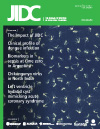Northward movement of East Central South African genotype of Chikungunya virus causing an epidemic between 2006-2010 in India
DOI:
https://doi.org/10.3855/jidc.2136Keywords:
Chikungunya virus, E1 gene, Sequence, Genotype, IndiaAbstract
Introduction: Re-emergence of chikungunya virus in South India after a gap of 32 years in 2006 affected over a million people in the Indian subcontinent. We kept a close vigil over the emerging trend of this virus between 2006-2010 with a view to establish the identity of the circulating genotype(s) and to determine the route of virus transmission in different parts of India.
Methodology: Nucleotide sequencing of the E1 gene region from 36 strains of chikungunya virus from three states in northern India was performed for this present study. Forty-four previously reported E1 sequences, retrieved from the global genome data base were used for making a phylogenetic tree.
Results: BLAST search revealed 99% homology of the northern Indian strains of the 2006-2010 outbreak with the Reunion Island isolates of 2006. Northern Indian strains of this study clustered with the East Central South African (ECSA) genotype.
Conclusions: Findings indicate that the currently circulating strain of chikungunya virus in northern India had its origin from the 2006 epidemic strain of South India that moved toward northern India via the western central India between 2006-2010 in a phased manner with dominance of the ECSA genotype and not the Asian genotype.
Downloads
Published
How to Cite
Issue
Section
License
Authors who publish with this journal agree to the following terms:
- Authors retain copyright and grant the journal right of first publication with the work simultaneously licensed under a Creative Commons Attribution License that allows others to share the work with an acknowledgement of the work's authorship and initial publication in this journal.
- Authors are able to enter into separate, additional contractual arrangements for the non-exclusive distribution of the journal's published version of the work (e.g., post it to an institutional repository or publish it in a book), with an acknowledgement of its initial publication in this journal.
- Authors are permitted and encouraged to post their work online (e.g., in institutional repositories or on their website) prior to and during the submission process, as it can lead to productive exchanges, as well as earlier and greater citation of published work (See The Effect of Open Access).








